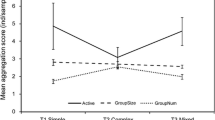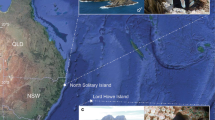Abstract
The emergence of an animal’s personality is the result of interactions between genetics, environment and experience. It is known that individuals are able to modulate their behaviour according to the context or the social environment. Many studies have shown for example, that familiarity among conspecifics diminishes aggressiveness, although little is known about the underlying processes. Nevertheless, personality traits have long been determined while ignoring the social context, especially in lower vertebrates such as fish. In the present experiment, we hypothesize that group connections (network density) may be positively correlated to consistency of aggressiveness by avoiding over-aggressive acts in further encounters. To test this hypothesis, we used eels (Anguilla anguilla) as a model species and monitored both aggressiveness and sociability in 64 individuals over their first 7 months of growth from the glass eel stage. As expected, social fish were less aggressive than their non-social counterparts at all times, highlighting the existence of a behavioural syndrome in eels. Additionally, rank-order consistency of aggressiveness was higher in groups of fish with high social connectivity, compared to those in less-connected fish groups. While aggressiveness must be consistent to be considered a personality trait, our results suggest that both aggressiveness and its consistency are influenced by initial social context.




Similar content being viewed by others
References
Bakker TCM (1986) Aggressiveness in sticklebacks (Gasterosteus aculeatus L.): a behaviour-genetic study. Behaviour 98:1–144
Bardonnet A, Rigaud C, Labonne J (2005) Etude expérimentale des comportements de civelles d’Anguilla anguilla L. influence de la densité et de la disponibilité en abris. B Fr Pêche Piscic 378-379:47–65
Bardonnet A, Labonne J, Laffite J, Garnier J (2009) Relationships between individual behaviour and morphometry under different experimental conditions of temperature and feeding in glass eels (Anguilla anguilla). Knowl Manag Aquat Ec 02:390–391
Bates D, Maechler M, Dai B (2008) lme4: Linear mixedeffects models using S4 classes. R package. http://www.citeulike.org/user/aidankeane/article/7112638
Bell AM, Stamps JA (2004) Development of behavioural differences between individuals and populations of sticklebacks, Gasterosteus aculeatus. Anim Behav 68:1339–1348
Bell AM, Hankison SJ, Laskowski KL (2009) The repeatability of behaviour: a meta-analysis. Anim Behav 77:771–783
Benus RF, Bohus B, Koolhaas JM, van Oortmerssen GA (1991) Heritable variation for aggression as a reflection of individual coping strategies. Experientia 47:1008–1019
Bergmüller R, Taborsky M (2010) Animal personality due to social niche specialisation. Trends Ecol Evol 25:504–511
Beyer K, Gozlan RE, Copp GH (2010) Social network properties within a fish assemblage invaded by non-native sunbleak Leucaspius delineatus. Ecol Modell 221:2118–2122
Biro PA, Beckmann C, Stamps JA (2010) Small within-day increases in temperature affects boldness and alters personality in coral reef fish. Proc R Soc Lond B 277:71–77
Brown C, Burgess F, Braithwaite VA (2007) Heritable and experiential effects on boldness in a tropical poeciliid. Behav Ecol Sociobiol 62:237–243
Butts CT (2007) sna: Tools for Social Network Analysis. http://erzuli.ss.uci.edu/R.stuff. R package version 1.5
Colléter M, Brown C (2011) Personality traits predict hierarchy rank in male rainbowfish social groups. Anim Behav 81:1231–1237
Colombo G, Grandidr G (1996) Histological study of the development and sex differentiation of the gonad in the European eel. J Fish Biol 48:493–512
Conrad JL, Weinersmith KL, Brodin T, Saltz JB, Sih A (2011) Behavioural syndromes in fishes: a review with implications for ecology and fisheries management. J Fish Biol 78:395–435
Croft DP, James R, Ward AJW, Botham MS, Mawdsley D, Krause J (2005) Assortative interactions and social networks in fish. Oecologia 143:211–219
Croft DP, Krause J, Darden SK, Ramnarine IW, Faria JJ, James R (2009) Behavioural trait assortment in a social network: patterns and implications. Behav Ecol Sociobiol 63:1495–1503
Dall SRX, Houston AI, McNamara JM (2004) The behavioural ecology of personality: consistent individual differences from an adaptive perspective. Ecol Lett 7:734–739
Degani G, Lee-Gallagher M (1985) The relationship between growth, food conversion and oxygen consumption in developed and underdeveloped American eels, Anguilla rostrata Lesueur. J Fish Biol 27:635–641
Degani G, Gallagher ML, Meltzer A (1989) The influence of body size and temperature on oxygen consumption of the European eel, Anguilla anguilla. J Fish Biol 34:19–24
R Development Core Team, 2009. R: A language and environment for statistical computing, R Foundation for Statistical Computing, Vienna, Austria, http://cran.r-project.org/
Dingemanse NJ, Kazem AJN, Réale D, Wright J (2010) Behavioural reaction norms: animal personality meets individual plasticity. Trends Ecol Evol 25:81–89
Dou S-Z, Tsukamoto K (2003) Observations on the nocturnal activity and feeding behavior of Anguilla japonica glass eels under laboratory conditions. Environ Biol Fish 67:389–395
Drent PJ, van Oers K, van Noordwijk AJ (2003) Realized heritability of personalities in the great tit (Parus major). Proc R Soc Lond B 270:45–51
Fisher JB (1954) Evolution and bird sociality. In: Huxley J, Hardy AC, Ford EB (eds) Evolution as a process. Allen & Unwin, London, pp 71–83
Geffroy B, Bardonnet A (2012) Differential effects of behaviour, propensity to migrate and recruitment season on glass eels and elvers’ growing performance. Ecol Fresh Fish 21:469–482
Geffroy B, Guiguen Y, Fostier A, Bardonnet A (2013) New insights regarding gonad development in European eel: evidence for a direct ovarian differentiation. Fish Physiol Biochem 39:1129–1140
Gosling SD, John OP (1999) Personality dimensions in nonhuman animals a cross-species review. Curr Dir Psychol Sci 8:69–75
Griffiths SW, Magurran AE (1999) Schooling decisions in guppies (Poecilia reticulata) are based on familiarity rather than kin recognition by phenotype matching. Behav Ecol Sociobiol 45:437–444
Harcourt JL, Ang TZ, Sweetman G et al (2009) Social feedback and the emergence of leaders and followers. Curr Biol 19:248–252
Höjesjö J, Johnsson JI, Petersson E, Järvi T (1998) The importance of being familiar: individual recognition and social behavior in sea trout (Salmo trutta). Behav Ecol 9:445–451
Hudson R, Bautista A, Reyes-Meza V et al (2011) The effect of siblings on early development: a potential contributor to personality differences in mammals. Dev Psychobiol 53:564–574
Huntingford FA (1976) The relationship between anti-predator behaviour and aggression among conspecifics in the threespined stickleback. Anim Behav 24:245–260
Imbert H, Beaulaton L, Rigaud C, Elie P (2007) Evaluation of visible implant elastomer as a method for tagging small European eels. J Fish Biol 71:1546–1554
Knights B (1987) Agonistic behaviour and growth in the European eel, Anguilla anguilla L., in relation to warm-water aquaculture. J Fish Biol 31:265–276
Krause J, James R, Croft DP (2010) Personality in the context of social networks. Philos T Roy Soc B 365:4099–4106
Kurvers RHJM, Adamczyk VMAP, Kraus RHS, Hoffman JI, Van Wieren SE, Van der Jeugd HP, Amos W, Prins HHT, Jonker RM (2013) Contrasting context dependence of familiarity and kinship in animal social networks. Anim Behav 86:993–1001
Magnhagen C, Staffan F (2005) Is boldness affected by group composition in young-of-the-year perch (Perca fluviatilis)? Behav Ecol Sociobiol 57:295–303
Matessi G, Matos RJ, Peake TM, McGregor PK, Dabelsteen T (2010) Effects of social environment and personality on communication in male Siamese fighting fish in an artificial network. Anim Behav 79:43–49
Medcof JC (1966) Incidental records on behaviour of eels in lake Ainslie, Nova Scotia. J Fish Res Bd Can 23:1101–1105
Nelson XJ, Wilson DR, Evans CS (2008) Behavioral syndromes in stable social groups: an artifact of external constraints? Ethology 114:1154–1165
Oosten JE, Magnhagen C, Hemelrijk CK (2010) Boldness by habituation and social interactions: a model. Behav Ecol Sociobiol 64:793–802
Øverli Ø, Pottinger TG, Carrick TR, Øverli E, Winberg S (2002) Differences in behaviour between rainbow trout selected for high- and low-stress responsiveness. J Exp Biol 205:391–395
Pike TW, Samanta M, Lindström J, Royle NJ (2008) Behavioural phenotype affects social interactions in an animal network. Proc R Soc Lond B 275:2515–2520
Réale D, Reader SM, Sol D, McDougall PT, Dingemanse NJ (2007) Integrating animal temperament within ecology and evolution. Biol Rev 82:291–318
Ricci L, Summers CH, Larson ET, O’Malley D, Melloni RH Jr (2013) Development of aggressive phenotypes in zebrafish: interactions of age, experience and social status. Anim Behav 86:245–252
Schartl M, Walter RB, Shen Y et al (2013) The genome of the platyfish, Xiphophorus maculatus, provides insights into evolutionary adaptation and several complex traits. Nat Genet 45:567–572
Schuett W, Tregenza T, Dall SRX (2010) Sexual selection and animal personality. Biol Rev 85:217–246
Schürch R, Heg D (2010) Variation in helper type affects group stability and reproductive decisions in a cooperative breeder. Ethology 116:257–269
Schürch R, Rothenberger S, Heg D (2010) The building-up of social relationships: behavioural types, social networks and cooperative breeding in a cichlid. Philos T Roy Soc B 365:4089–4098
Sih A, Bell A, Johnson JC (2004) Behavioral syndromes: an ecological and evolutionary overview. Trends Ecol Evol 19:372–378
Sih A, Hanser SF, McHugh KA (2009) Social network theory: new insights and issues for behavioral ecologists. Behav Ecol Sociobiol 63:975–988
Stamps JA (2007) Growth-mortality tradeoffs and “personality traits” in animals. Ecol Lett 10:355–363
Stamps J, Groothuis TGG (2010) The development of animal personality: relevance, concepts and perspectives. Biol Rev 85:301–325
Tesch FW (2003) Post-larval ecology and behaviour. In: Tesch FW, Thorpe JE (eds) The eel, 3rd edn. Blackwell Science Ltd, Oxford, pp 181–183
Utne-Palm AC, Hart PJB (2000) The effects of familiarity on competitive interactions between threespined sticklebacks. Oikos 91:225–232
Ward AJW, Hart PJB (2003) The effects of kin and familiarity on interactions between fish. Fish Fish 4:348–358
Ward AJW, Thomas P, Hart PJB, Krause J (2004) Correlates of boldness in three-spined sticklebacks (Gasterosteus aculeatus). Behav Ecol Sociobiol 55:561–568
West SG, Ryu E, Kwok OM, Cham H (2011) Multilevel modeling: current and future applications in personality research. J Pers 79:2–50
Wilson ADM, Godin J-GJ (2009) Boldness and behavioral syndromes in the bluegill sunfish, Lepomis macrochirus. Behav Ecol 20:231–237
Wilson ADM, Krause S, Dingemanse NJ, Krause J (2013) Network position: a key component in the characterization of social personality types. Behav Ecol Sociobiol 67:163–173
Acknowledgments
Benjamin Geffroy’s PhD thesis was funded by the University of Pau and Pays Adour (ED 211). The project was supported by funding from the Office National de l’Eau et des Milieux Aquatiques (ONEMA) and by the Interreg IV B Atlantic area transnational programme (European Regional Development Fund), in the context of the Arc Atlantic Resource Conservation programme (AARC). We wish to thank Emmanuel Huchet for setting up the aquaria. We also thank Martin Walton and Rosie Cox for the English language corrections. We also acknowledge two anonymous reviewers whose commentaries greatly improve quality of the manuscript, as well as Jacques Labonne for his stimulating discussion.
Ethical standards
All works herein comply with current French national laws on the handling of animals and were approved by local ethics committee, research protocol STP-E 0912.
Conflict of interest
The authors declare that they have no conflict of interest.
Author information
Authors and Affiliations
Corresponding author
Additional information
Communicated by D. P. Croft
Rights and permissions
About this article
Cite this article
Geffroy, B., Bru, N., Dossou-Gbété, S. et al. The link between social network density and rank-order consistency of aggressiveness in juvenile eels. Behav Ecol Sociobiol 68, 1073–1083 (2014). https://doi.org/10.1007/s00265-014-1719-6
Received:
Revised:
Accepted:
Published:
Issue Date:
DOI: https://doi.org/10.1007/s00265-014-1719-6




